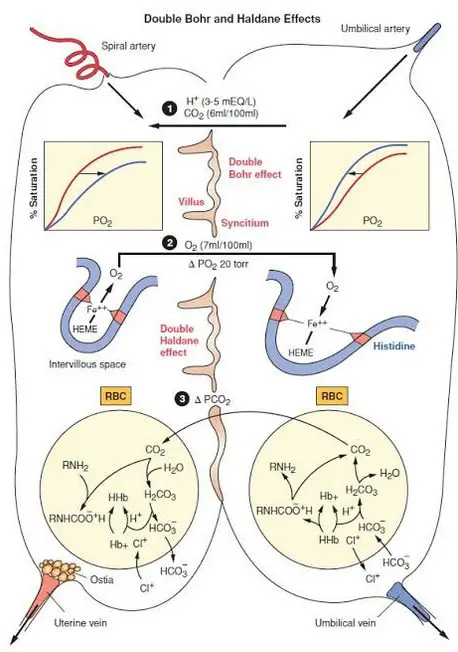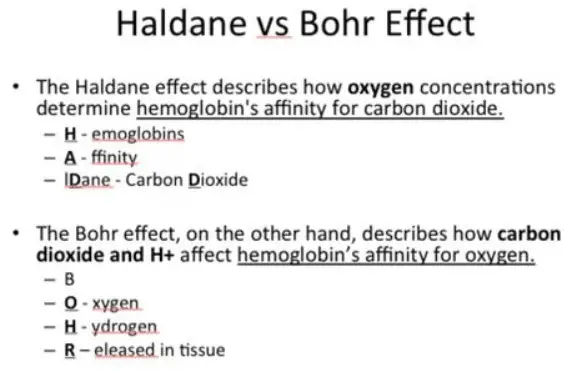What is the Haldane effect?
It is a phenomenon where the oxygen binds to hemoglobin to enable the release of carbon dioxide. It is more like a mirror image of the Bohr effect. These effects are essential biochemical features that facilitate the exchange of carbon dioxide for oxygen in both peripheral and pulmonary circulations.
The Haldane effect was initially described by John Scott Haldane where the name was derived. The lungs oxygenate the blood and displace carbon dioxide from hemoglobin leading to increased carbon dioxide removal. The oxygenated blood reduced its carbon dioxide affinity. It is the high concentration of carbon dioxide that enables the dissociation of oxy-hemoglobin. (1, 2, 3, and 4)

Image 1: The image shows a comparison image between Haldane effect and Bohr effect.
Picture Source: encrypted-tbn0.gstatic.com
What triggers the Haldane effect?
- The binding of oxygen to hemoglobin, which reduces the affinity of the protein for carbon dioxide in carbaminohemoglobin form. The binding of oxygen to hemoglobin shifts hemoglobin-bound carbon dioxide thereby speeding up the release of carbon dioxide in the lungs.
- The binding of oxygen gives hemoglobin a more acidic molecule causing the release of free hydrogen ions. The increase in the concentration of hydrogen ions secondary to oxygen binding causes a reversible equilibrium between carbon dioxide and bicarbonate in the carbon dioxide direction. More so, the binding of oxygen to hemoglobin enables the conversion of bicarbonate to carbon dioxide in the pulmonary circulation thereby enhancing the elimination of carbon dioxide. (3, 4, 5, and 6)
If you look at the Haldane effect, it simply shows a high oxygen concentration enhances carbon dioxide unloading. On the other hand, low oxygen concentration enables carbon dioxide loading onto hemoglobin. The changes in the carbon dioxide level are caused by oxygen.
The Haldane effect is somewhat related with the Bohr effect, but there’s a difference. In the Bohr effect, the carbon dioxide and H+ influences the affinity of hemoglobin for oxygen. The affinity for oxygen decreases if the concentrations of carbon dioxide and H+ are high. On the other hand, low concentrations of carbon dioxide and H+ causes high affinity for oxygen. (3, 5, 6, and 7)

Image 2: The image above shows a double Haldane and double Bohr effect.
Picture Source: encrypted-tbn0.gstatic.com
What is Double Haldane Effect?
The double Haldane effect usually takes place in the intra-uterine life, specifically, in the utero-placental circulation wherein the affinity of fetal carbon dioxide decreases and enhances the update of maternal carbon dioxide. The intake of oxygen caused by fetal blood takes place, the release of carbon dioxide is triggered. The double Haldane effect is the one responsible for about 46% of the trans-placental dioxide transfer. (7, 8)
Difference between the Haldane effect and Bohr effect
Haldane effect and Bohr effect are used interchangeably but it is important to know the difference between the two. In Bohr effect, there is a binding of oxygen to hemoglobin in the lungs leading in a leftward shift of oxy-hemoglobin dissociation curve.
The release of oxygen from hemoglobin in tissues of the body causes rightward shift of the curve. On the other hand, the Haldane effect shows how the concentration of oxygen can find out the affinity of hemoglobin towards carbon dioxide. (9, 10)

Image 3: Haldane effect graph as shown in the image above.
Picture Source: encrypted-tbn0.gstatic.com

Mnemonic for students to remember these effects 🙂
Factors affecting the affinity of hemoglobin for oxygen
There are different physiological factors leading to the affinity of hemoglobin for oxygen. Some of these factors can be controlled while others we have no control over. Some of these factors include the following:
- Partial pressure of carbon dioxide
- pH that is independent of carbon dioxide
- temperature
- concentration of 2,3-DPG in the erythrocytes
- unusual hemoglobin species. (2, 4, and 5)
The discovery of the Haldane effect
John Scott Haldane is the one who discovered the Haldane effect. He is a British physiologist and philosopher. He was born in 1860 in Edinburgh, Scotland. He was investigating poisonous gases that takes place in sunstroke, coal mines and wells, as well as the physiological action of carbon monoxide.
He also investigated the use of a caged canary for detecting monoxide, lung ventilation regulation, and came up with haemoglobinometer. It is an apparatus sued for blood-gas analysis.
John Scott Haldane was also the one who described the effect of oxygen deficiency and exercise on breathing. Haldane worked on the effects of poisonous gases during World War I he designed a portable oxygen administration apparatus.
John Scott Haldane’s work on hypoxia and acclimatization of the human body to high altitude paved a way to the concept of respiratory physiology. (2, 6, 8, and 10)
References
- https://en.wikipedia.org/wiki/Haldane_effect
- https://www.openanesthesia.org/haldane_effect/
- https://www.sciencedirect.com/topics/medicine-and-dentistry/haldane-effect
- http://www.pathwaymedicine.org/haldane-effect
- https://www.physiology.org/doi/full/10.1152/japplphysiol.00140.2018
- https://study.com/academy/answer/what-is-the-difference-between-the-bohr-and-haldane-effects.html
- http://www.interactive-biology.com/6717/the-haldane-effect-and-uptake-of-carbon-dioxide-from-tissues/
- https://www.tandfonline.com/doi/abs/10.3109/00365517309082411?journalCode=iclb20
- https://link.springer.com/chapter/10.1007/978-1-4615-1875-4_55
- http://archive.rubicon-foundation.org/xmlui/handle/123456789/10107
